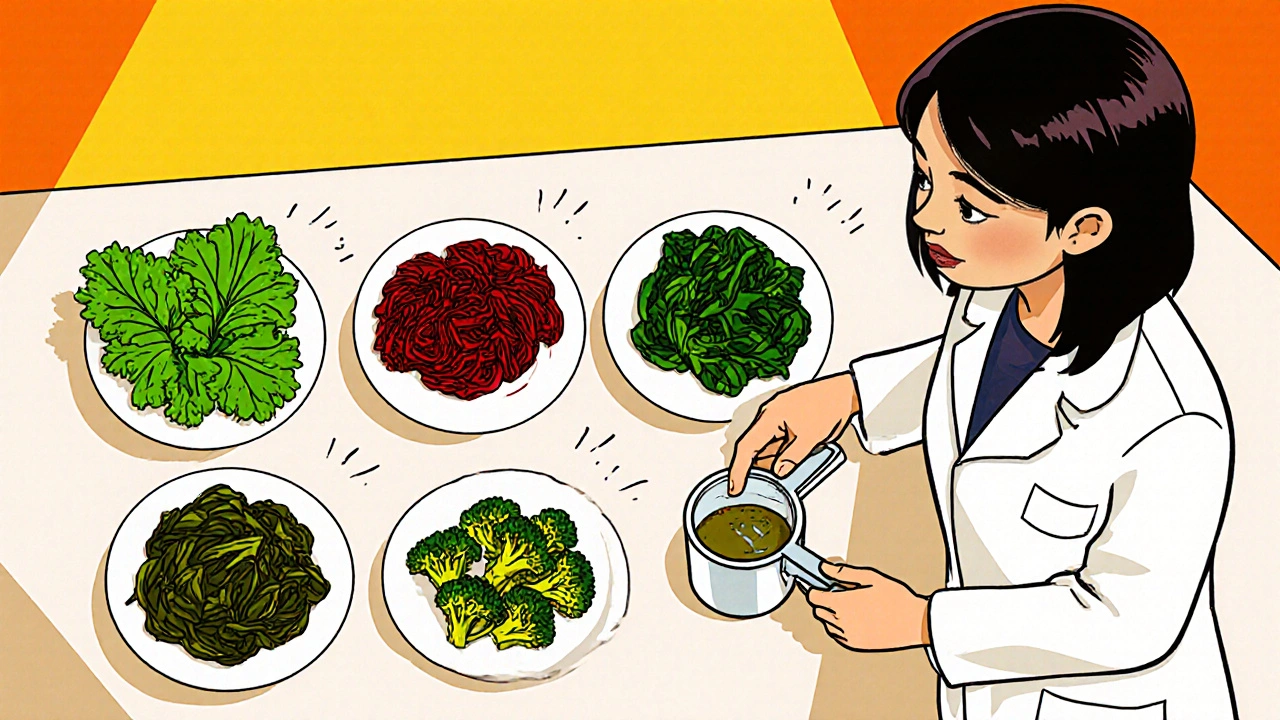Vitamin K Intake Calculator for Warfarin Patients
Daily Vitamin K Tracker
Calculate your vitamin K intake from common vegetables and see how it affects your INR.
Recommended intake: 60-180 µg daily for stability.
Your Daily Vitamin K Intake
Key Takeaways
- Warfarin’s effect is directly tied to how much vitamin K you eat each day.
- Stick to a consistent intake - usually 60‑180 µg of vitamin K daily - and avoid big swings.
- Leafy greens such as kale, spinach and collard greens are the biggest contributors; a half‑cup cooked serving can contain 300‑550 µg.
- Track your meals, keep the timing of vitamin K‑rich foods steady, and involve a dietitian early.
- Some non‑vegetable items (cranberry juice, grapefruit juice, certain supplements) can also throw your INR off.
Ever wondered why a single bowl of salad can send your warfarin diet “off the rails” overnight? The answer lies in the chemistry of vitamin K and how it competes with the blood‑thinner you’re prescribed. This guide walks you through the complete list of vitamin K‑rich vegetables, explains the science behind INR swings, and gives a step‑by‑step plan to keep your numbers steady.
How Warfarin and Vitamin K Interact
When you take Warfarin, it blocks the enzyme VKORC1 (vitamin K epoxide reductase complex). This prevents the recycling of vitamin K into its active form, which is needed for the liver to add a crucial carboxyl group to clotting factors II, VII, IX and X. Less active vitamin K means fewer functional clotting proteins and a thinner blood profile.
When you eat foods high in vitamin K, you flood the body with the very co‑factor warfarin is trying to starve. Each extra 100 µg of vitamin K can lower the International Normalized Ratio (INR) by roughly 0.2‑0.4 units, according to a 2019 NIH‑sponsored study. The opposite happens when you cut vitamin K dramatically - INR climbs and bleeding risk rises.
Because the dose‑response curve varies wildly between individuals (genetics, liver function, other meds), clinicians now advise “consistency over avoidance.” The 2023 Anticoagulation Forum position paper stresses that keeping daily vitamin K within a 20 % window of your personal baseline gives the most stable INR.
Complete List of Vitamin K‑Rich Vegetables
Below is the USDA‑validated roster of vegetables that pack the most vitamin K per typical serving. Values are expressed in micrograms (µg) of vitamin K per portion.
| Vegetable | Serving Size | Vitamin K (µg) |
|---|---|---|
| Kale | ½ cup cooked | 547 |
| Spinach | ½ cup cooked | 444 |
| Collard greens | ½ cup cooked | 418 |
| Turnip greens | ½ cup cooked | 265 |
| Swiss chard | ½ cup cooked | 299 |
| Mustard greens | ½ cup cooked | 210 |
| Broccoli | ½ cup cooked | 102 |
| Brussels sprouts | ½ cup cooked | 109 |
| Romaine lettuce | 1 cup shredded | 48 |
| Green cabbage | ½ cup cooked | 82 |
| Asparagus | ½ cup cooked | 70 |
| Parsley | ¼ cup fresh | 246 |
| Seaweed (dried) | 10 g | 45‑100 |
Notice how a modest half‑cup of kale already surpasses the daily recommended intake for most adults (90‑120 µg). That’s why the key is not to cut greens out, but to eat roughly the same amount each day.

Vitamin K’s Direct Effect on INR
The INR quantifies how long your blood takes to clot compared to a standard. Warfarin aims for a therapeutic window, typically 2.0‑3.0 for most indications. When you bump vitamin K intake by 150 % of your baseline (about 180 µg for men, 135 µg for women), the INR can drop 0.5‑1.0 units within 24‑48 hours. Conversely, halving your intake can raise INR by a similar margin within three to five days.
Figure 1 (not shown) from the 2021 NIH Clinical Center study illustrated a near‑linear relationship: each 100 µg swing moved the INR by roughly 0.3. The practical upshot? Even small, unplanned changes-like adding a side of sautéed kale to dinner-can shift your numbers enough to warrant a dose tweak.
Practical Management Steps
- Establish a baseline. Work with a certified dietitian to calculate how much vitamin K you typically consume. The Iowa Vitamin K Food Frequency Questionnaire is a validated tool.
- Pick a target range. Most clinicians suggest 60‑180 µg per day, depending on your INR goal and co‑morbidities.
- Choose consistent servings. For example, decide that you will eat ½ cup of cooked spinach on Tuesdays and Thursdays, and stick to that schedule.
- Document every meal. A simple spreadsheet or a smartphone photo log (the Anticoagulation Forum app works well) helps you spot accidental spikes.
- Time your greens. Eating vitamin K‑rich foods at the same time each day-preferably in the evening-reduces variability before the next morning INR draw.
- Review monthly. Bring your log to the anticoagulation clinic; dietitians can adjust your target if your INR stays stable.
Patients who followed a structured “Vitamin K Consistency Protocol” saw a 43 % drop in warfarin‑related ER visits (University of North Carolina, 2022). The biggest win was avoiding sudden “detox” attempts during illness, when many people slash all greens and unintentionally raise INR.

Other Foods and Drinks to Watch
While leafy vegetables dominate the conversation, a handful of non‑vegetable items can also move the needle.
- Cranberry juice. A 240 ml serving can increase INR by 0.8‑1.2 units within three days (UBC, 2020).
- Grapefruit juice. It blocks CYP2C9, the enzyme that metabolizes warfarin, raising drug levels by 15‑30 % (University of Florida, 2021).
- Vitamin K supplements. Over‑the‑counter tablets (e.g., Viactiv Calcium Chews) contain ~25 µg each; taking them sporadically can cause fluctuations.
- Alcohol. Moderate intake (≤1 drink/day) is usually safe, but binge drinking can impair liver metabolism and skew INR.
When you introduce any of these, note the timing and amount in your food diary and inform your provider.
When to Get Professional Help
If your INR moves outside the therapeutic range on two consecutive tests, or you notice any of these red flags, call your anticoagulation clinic immediately:
- Sudden increase in green‑vegetable portions (>30 % jump).
- New over‑the‑counter supplement or herbal product.
- Hospital admission, surgery, or a major infection.
- Changes in other meds that affect CYP2C9 (e.g., certain antibiotics, NSAIDs).
Early intervention often prevents a dose change and keeps you out of the emergency department.
Frequently Asked Questions
How much vitamin K is safe to eat each day while on warfarin?
Most guidelines suggest aiming for 60‑180 µg per day and keeping daily variation within ±20 %. That range works for the majority of patients, but your personal target should be set by your clinician.
Can I completely avoid leafy greens?
Avoiding them isn’t recommended. Eliminating vitamin K can make your INR soar and increase bleeding risk. Consistency, not avoidance, is the evidence‑based strategy.
What should I do if I accidentally eat a huge kale smoothie?
Record the amount, check your next INR (usually within 2‑3 days), and let your anticoagulation team know. They may hold a dose or simply observe if the INR stays in range.
Are vitamin K supplements ever useful for warfarin patients?
Controlled low‑dose supplementation (≈100 µg/day) has been shown to reduce INR swings (WARFARIN‑VITAMIN K trial). It should only be started under medical supervision.
How does cooking affect vitamin K content?
Boiling can lower vitamin K by 15‑20 % compared with steaming or raw consumption. Use the USDA values for raw or cooked as listed in the table to stay accurate.
Staying on top of your warfarin diet doesn’t have to be a headache. With a clear baseline, steady greens, and a simple log, you’ll keep your INR where it belongs and avoid unnecessary clinic visits.


Author
Mike Clayton
As a pharmaceutical expert, I am passionate about researching and developing new medications to improve people's lives. With my extensive knowledge in the field, I enjoy writing articles and sharing insights on various diseases and their treatments. My goal is to educate the public on the importance of understanding the medications they take and how they can contribute to their overall well-being. I am constantly striving to stay up-to-date with the latest advancements in pharmaceuticals and share that knowledge with others. Through my writing, I hope to bridge the gap between science and the general public, making complex topics more accessible and easy to understand.